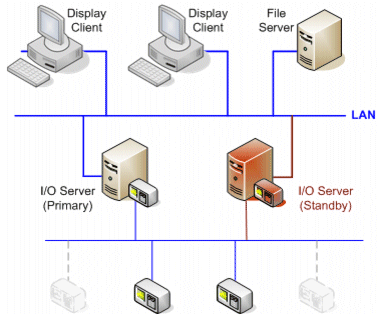
Systems with a single I/O Server can be interrupted by the inoperability of a single device or process. If the primary server isn't operating normally, control and monitoring of the system is lost. By introducing a second I/O Server and dedicating it to communicating with the same I/O Devices, the ability of a single device to influence the system as a whole is minimized. You now have a primary and standby I/O Server in your system where the standby I/O Server will assume operations in case the primary I/O Server becomes inoperative.
The diagram below illustrates the introduction of a standby I/O Server into the existing system. When the system is in operation, both I/O Servers are identically maintained.

Note: Although both I/O Servers are identical, it is important to recognize that the standby server is not duplicating the primary server's functions. If it were, the load on the PLC portion of the network would be double and would significantly reduce performance. Therefore, only the primary server communicates with the PLCs at any given time.
Redundancy is provided as follows:
When the system is running, you can also use redundant I/O Servers to split the processing load. This would result in higher performance as every I/O Server would be running in parallel when servicing the I/O Devices.
See Also